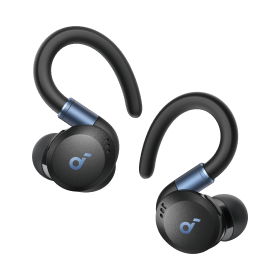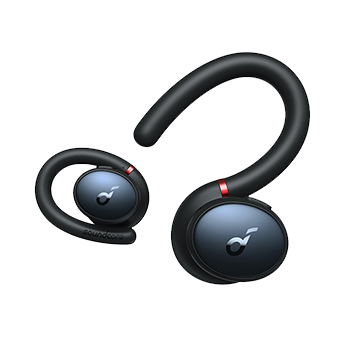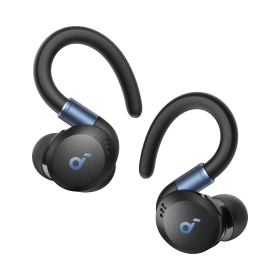How Do Bone Conducting Headphones Work?
Bone-conducting headphones are an alternative audio device to traditional headphones and in-ear earbuds. They have a neckband design that fits around the back of the head, while the bone-conduction speakers sit near the cheekbones. Because they have an open-ear design, they are used mainly by athletes who want to listen to music without compromising their awareness of their surroundings. If you are just hearing about it, you might be asking: How do bone-conducting headphones work? We will discuss what does bone conduction mean and why it makes sense for many people to use this product.

What Is Bone Conduction Headphones?
You are not alone when you ask what are bone conduction headphones. After all, these headphones have been around for just a decade.
Bone conduction headphones are sporty audio devices that deliver audio through vibrations. Unlike traditional headphones that provide sound through the air to the eardrums, bone-conducting headphones bypass the outer and middle ear by sending pulses directly through the bones of the skull to the inner ear.
To fully appreciate this technology, we must also answer the question: What is bone conduction? Simply put, bone conductivity is a technology where the audio device transmits vibrations through the temporal bone. These headphones free up the ear canal so you can still hear what’s going on in your surroundings while listening to music or taking calls.
If you still need clarification about what are bone conduction headphones, then we can delve more deeply into how they function and their various features.
How Do Bone Conducting Headphones Work?
Bone-conduction headphones transmit sound waves through the cheekbones directly through the inner ear. Unlike traditional headphones and in-ear earbuds, it bypasses the outer and middle ear when delivering sounds.
Here is a step-by-step explanation of how do bone conduction headphones work:
- The audio source, such as a music player or a smartphone, produces an electrical signal representing the audio content.
- A transducer or a vibrating element in the bone-conduction headphonesconverts the electrical signal into mechanical vibrations. This transducer is typically a piezoelectric or electromagnetic device.
- Then, the mechanical vibrations generated by the transducer are transmitted directly to the bones of the user's skull. The transducer is usually placed on the temporal bone, just in front of the ear.
- As the vibrations pass through the bones of the skull, they stimulate the cochlea, the spiral-shaped, fluid-filled structure in the ear responsible for hearing. The cochlea converts these vibrations into electrical signals that the brain interprets as sound.
- Finally, the brain processes the electrical signals from the cochlea, allowing the user to perceive the sound without needing sound waves to travel through the ear canal.
Here's a simple explanation if you are wondering how to use bone-conduction headphones.
First, make sure that the headphones are positioned correctly before pressing the power button on the headphones to turn them on. Next, pair it with your smartphone or computer through Bluetooth. You can also adjust the volume using dedicated buttons. To turn it off, you only need to press the power button again.
What Are the Pros and Cons of Bone Conduction Headphones?
Bone-conduction headphones, being a novel technology, have received a range of feedback. Below are the drawbacks and benefits of bone-conduction headphones that you should be aware of:
Pros
- Promotes situational awareness thanks to its open-ear design that lets you listen to your surroundings.
- It lessens the chances of damaging your middle and inner ear.
- Some people find it more comfortable to wear because they don’t suffer from in-ear earphones ear fatigue.
- Most models have a high waterproof rating, which makes them excellent for outdoor activities such as running or cycling.
- It’s great for people who are experiencing hearing loss because of issues in their middle ear.
Cons
- Bone conduction headphoneshave subpar sound quality compared to in-ear earbuds.
- Most models lack the deep bass response that in-ear earbuds provide. Furthermore, it often has lower volume levels.
- Fitting the bone-conduction headphones is challenging for some people, especially those with long hair or glasses.
Best Bone Conduction Headphone
Now that we have answered how does bone-conduction headphones work, it’s time to look for one of the best conduction headphones on the market. We’ve looked into several models online, but the Shokz OpenRun stands out the most because of its overall performance and value for money.
Shokz OpenRun
The Shokz Open Run is one of the best headphones that use bone conduction. It’s the flagship model from Shokz, and they didn’t hold back on giving it the best features. According to its manufacturer, these headphones are 30% smaller and 13% lighter than their predecessors.
It has an IP67 waterproof rating, so you wouldn’t have to worry about sweat getting around it while doing physical activities. It has a respectable eight hours of battery life. Shokz also improved its sound quality as it now delivers more bass while reducing the vibrations and sound leakage
If you are wondering how to pair bone-conduction headphones, here’s how. First, make sure your smartphone or computer’s Bluetooth is on. Turn on your headphones and press the designated button for pairing. Select the headphone device you want to pair from your phone or PC. You will then get a voice notification in your headphones that it is now connected to the device.
Best Alternative: soundcore AeroFit Air Conduction Headphones
Besides bone-conducting headphones, another variety of open-ear headphones exists, like the soundcore AeroFit. These headphones offer a unique listening experience by delivering sound through the ear canal without sealing it off, allowing for ambient awareness. This design is beneficial for outdoor activities where situational awareness is crucial, such as running or cycling.

soundcore AeroFit
The soundcore AeroFit is an open-air headphone that lets you hear your surroundings entirely while it sits in your ear canal. In this regard, it’s almost similar to the benefits of the open-ear design of bone-conduction headphones.
This true-wireless open-style earbud has a battery life of 11 hours, while its Pro version has 14 hours. It features Multipoint Connection, which lets you connect to multiple devices simultaneously. Meanwhile, its IPX7 water resistance rating means it can withstand sweat and a bit of drizzle.
The sound quality is also superb. It supports LDAC codec, allowing high-resolution audio even when using Bluetooth. Furthermore, it comes with a neckband if you need more support for the earbuds, so they are more secure and won’t fall off your head.
There are several reasons why air conduction is better than bone conduction. Its sound quality and bass response are generally better. They also provide better noise isolation, which means other people can’t listen to whatever is playing in your earbuds.
FAQ
Can Other People Hear Bone Conduction Headphones?
Under normal volume and at a social distance of over 1 meter, it's unlikely for others to hear sound from bone conduction headphones. This makes them suitable for confident use in public or social settings.
Do Bone Conduction Headphones Work?
Yes, bone-conduction headphones do work effectively. They are excellent audio devices, particularly suited for outdoor activities. By transmitting sound through skull vibrations, they allow users to enjoy music or calls while remaining aware of their surroundings, making them a safe and practical option for active lifestyles.
Conclusion
Bone-conduction headphones are excellent for people looking for alternatives to in-ear earbuds and other traditional audio devices. Its open-ear design will surely be appreciated by people who want to be aware of their surroundings while listening to their vibe or taking a call. Meanwhile, you can also benefit from open-ear headphones like soundcore AeroFit. Whether you go for bone conduction or open-ear headphones, both have something special to offer.

















































